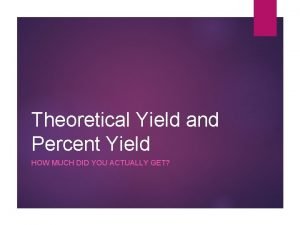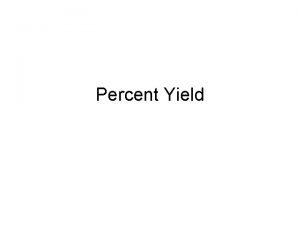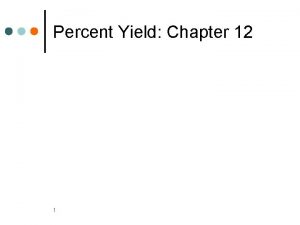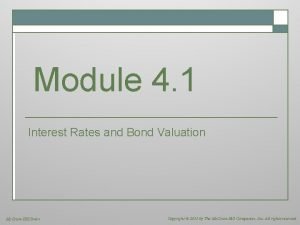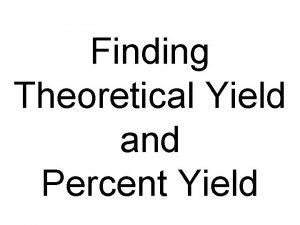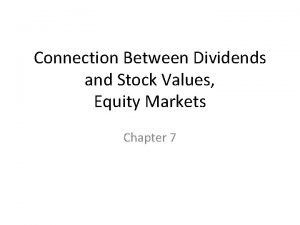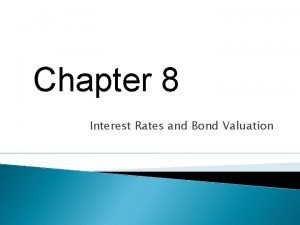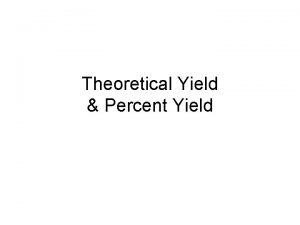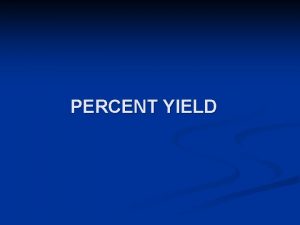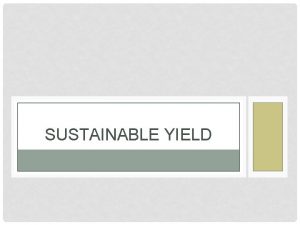Chapter 5 The Yield Test Yield Test Used







- Slides: 7

Chapter 5: The Yield Test

Yield Test • Used to determine the amount of edible product (EP; also referred to as yield) and the amount of waste product (WP) of a food item • The higher the yield of an item, the greater the number of portions that will be available and the higher the profit Fundamentals of Menu Planning 3 rd edition. (Mc. Vety, Ware and Ware) John Wiley & Sons, Inc. © 2009

Yield Test Cont’d • Specifications determine a standard quality in a food product. Examples include: ▫ ▫ ▫ ▫ ▫ Weight Color Shape Grade Texture Size Odor Packaging Product temperature Yield grade Fundamentals of Menu Planning 3 rd edition. (Mc. Vety, Ware and Ware) John Wiley & Sons, Inc. © 2009

Types of Yield Tests • Two types ▫ Convenience food yield test �Conducted on items that have been packaged into cans, bags and boxes �This test determines if the amount of packaging is within the specifications stated. �If the amount of packing is different than the specifications stated management is losing money by paying for excess packing. Fundamentals of Menu Planning 3 rd edition. (Mc. Vety, Ware and Ware) John Wiley & Sons, Inc. © 2009

Types of Yield Tests ▫ Fresh food yield test �Done on food items that are purchased in an unaltered, fresh state. �Test consists of weighing food items both before starting any type of preparation, and after completing the final preparation �There are eight steps. Fundamentals of Menu Planning 3 rd edition. (Mc. Vety, Ware and Ware) John Wiley & Sons, Inc. © 2009

Fresh Food Yield Test: 8 Steps 1. The fresh food product is weighed as it is received. 2. The fresh food product is weighed after it comes out of storage. Most foods lose weight during storage through evaporation 3. Any undesirable parts, such as fat, bones, outer leaves, etc. 4. The fresh food product is washed and weighed. (At this point, the convenience food yield test also can be calculated). 5. The food is prepared and cooked. The food is weighed to determine the amount of weight loss caused through shrinkage during the cooking stage. 6. The food product is cut into portion sizes. 7. The food product is cut to determine the amount of edible product lost during the portioning or carving stage. 8. Once the food item has been cut into the total number of portions the amount of waste product is totaled. Fundamentals of Menu Planning 3 rd edition. (Mc. Vety, Ware and Ware) John Wiley & Sons, Inc. © 2009

Calculating a Yield Test • Step 1: Establish the AP weight. • Step 2: Calculate the amount of waste • Step 3: Calculate the edible product using the formula: ▫ AP weight – Waste product = Edible product • Step 4: Convert the edible product unit of measurement (possibly pounds to ounces), if the single portion size to be served is different from the edible product amount. ▫ Edible product x 16 oz (1 lb) = Total number of portions • Step 5: Calculate the number of individual portions available. Then divide the total number of portions available by the individual portion size to get the number of portions available. • Step 6: Establish the individual portion cost. Take the total cost and divide it by the total number of portions. This equals the individual portion cost. Fundamentals of Menu Planning 3 rd edition. (Mc. Vety, Ware and Ware) John Wiley & Sons, Inc. © 2009
